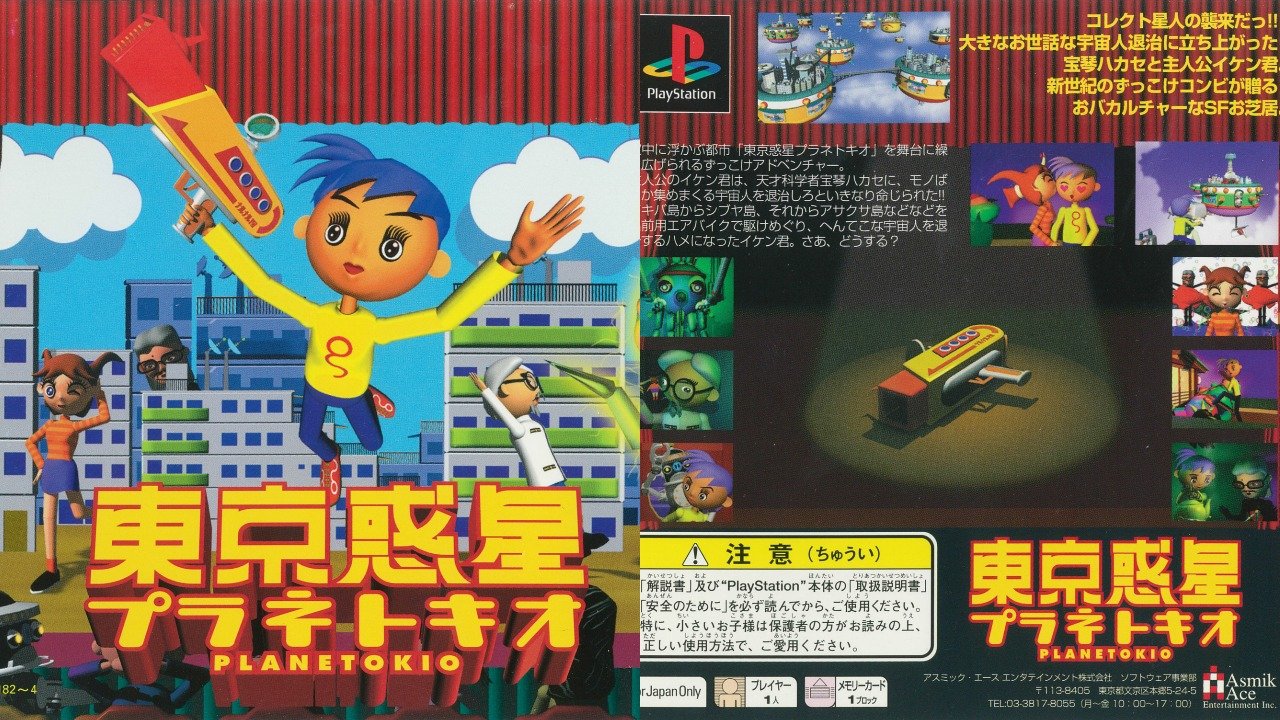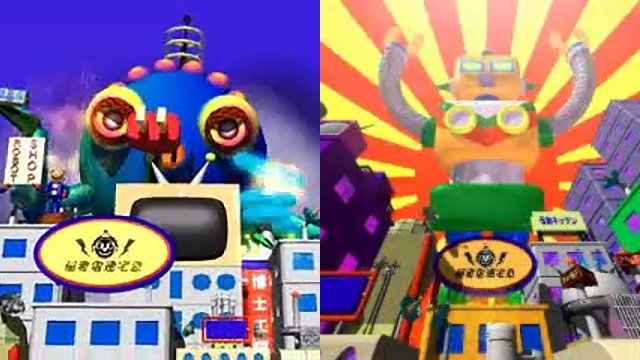Osamu Sato is an artist of visual and audio mediums, and at one point, in the 1990s, he was a game developer. Looking at Sato’s work, it’s evident that being a game developer always came second to his passion for art, and he’s been quoted as saying that he lost interest in the medium when it became too restrictive for him to experiment. He worked on seven games (that we know of) before he retired from the industry, and each title fell into relative obscurity until around 2009. Let’s Plays of his most recognized title, LSD: Dream Emulator, began gaining popularity on YouTube, and from those Osamu Sato has earned a cult following in the West.
Plenty has been said about LSD, and his two trippy PC/Mac adventures, Eastern Mind and Chu-Teng, but the remainder of-of his short catalog of games are still relatively unexamined by English-speakers. LSD is rare and expensive, Eastern Mind’s English version has been spotted less than ten times, Chu-Teng was a myth until a single copy was found in 2014, and two of the other four games he made have been completely lost to time.
The irony in the heavy focus on Sato’s rare and lost works is that the two games he was involved with making that are most common, Tokyo Wakusei Planetokio and Rhythm ‘N’ Face for the Playstation, are often overlooked by his fanbase. These two titles might not be as surreal, and at times nonsensical, as his other works, but they both unmistakably carry the strange and colorful touch of Osamu Sato. In this article, we’ll cover Tokyo Wakusei Planetokio in-depth in a look at one of the bizarre action-adventure RPGs for the PlayStation.
Tokyo Wakusei Planetokio: Vital Stats

Tokyo Wakusei Planetokio (東京惑星プラネトキオ) was developed by OutSide Directors Company and published by Asmik Ace Entertainment. It released in Japan only on August 26, 1999. If you try to find much more information than that (at least in English) you’re going to be out of luck. Besides a small bit of info on an obscure wiki, there’s not a lot of history known about this game.
Even the fate of OutSide Directors Company isn’t known, though their website remains just as it was when it projects stopped being made under that name in the early 2000s. Asmik Ace hasn’t published a game since the days of the PS2 and now operates as a movie and anime distributor.
How exactly Planetokio was received in Japan upon its release is another obscurity. I’m sure Famitsu and other game publications of the time reviewed it, but those pages are beyond my ability to find. Getting current issues of Famitsu in the US is hard, much less finding one from nineteen years ago. Evidently, it didn’t make much of a splash as there’s hardly any mention of it on Japanese-language sites.
Tokyo Wakusei Planetokio: What’s it About?
In the near future, a giant earthquake destroys Tokyo. The surviving citizens of the city band together and build a new city in the sky, Planetokio, which gives Tokyo Wakusei Planetokio its namesake. The main character is Iken, who is a ramen delivery boy that works for Rai Rai Ken ramen shop and is part of the Planetokio Defense Squad headed by Dr. Hokin (whose lab is in the basement of the ramen shop).
The story gets rolling when the news is announced that an alien is preparing to attack the Akihabara Island district of Planetokio. Iken and Dr. Hokin had been working on the Naru Naru MK1 gun to combat aliens. Dr. Hokin is a mad scientist, so without any time for proper trials, he decides to test the weapon on Iken. By the time the test is over (and Iken recovers), the alien has reached Akihabara.
Iken takes the gun and prepares to head to Akihabara Island to combat the alien. On his way out of the ramen shop, the owner Lailai asks you to take the Brainiac Ramen to Mr. Mouden on your way. As you exit the store to the parking lot, a thief runs into Iken and steals the ramen, and that’s where the player gets control.
The story continues with Iken chasing down the thief and eventually facing off against the alien on Akihabara. The main thing to keep in mind about the game is that the plot uses a lot of cartoon logic. It’s best not to try and make too much sense of it, as it’s mostly just a goofy, surreal game. Planetokio is a ridiculous place, and the aliens trying to invade it have little to no motivation.
In fact, whether or not you get the good or bad ending is dependant on whether you completed your stamp collection or not during the game. A task that is very much in side quest territory, and wouldn’t seem to have any bearing on the outcome at all.
Tokyo Wakusei Planetokio: Why is This Game Worth Looking At?
There are several reasons why this obscure, seemingly average game is worth examining. Sato’s art has this unique, clean, artificial look, which gives seemingly ordinary objects a sort of menacing feeling. This extends to Tokyo Wakusei Planetokio. While on the surface the game is colorful, nonsensical, and seems to be geared towards younger players, Sato’s design infuses it with a particular something that makes it intriguing and uncomfortable to watch at the same time.
Sato’s visual aesthetic in the game was limited by the technology of the time, and Tokyo Wakusei Planetokio‘s cutscenes have that strange 1990s CG look and movement to them that is reminiscent of TV series like Reboot. The sparse textures and odd actions of the characters fuel a ton of nostalgia for those old CG kid’s shows and FMV games. Considering the game was released in late 1999, this was the height of that style of animation before the better tech of the PS2, GameCube, Dreamcast, and Xbox allowed developers to craft models with more detail.
There’s a lot of full-motion video in the game too. A big reason it spans three discs is because of the massive amount of voiced video you’ll encounter. Unlike most RPGs of the era, almost every conversation you have in Tokyo Wakusei Planetokio will consist of a video clip in a pop-up box which features a full voice over. Additionally, there are plenty of cutscenes stuffed in between gameplay.
The game has an interesting blend of gameplay that would likely get critical acclaim if introduced in an indie game these days. Tokyo Wakusei Planetokio is split into three primary parts with the emphasis being on exploration. During some of the game you have to roam around a town and pick up items, usually to unlock a door or continue through a maze. There is a maze in each of the seven chapters that you’ll have to make your way through. Finally, there is a boss fight in each section that presents itself as an RPG-like turn-based fight but depends on you using the right items in the correct sequence.
The throwback graphics and varied gameplay make this game stand out among its contemporaries, and its insight into the mind of Osamu Sato makes it a must-play for fans of his work. Unfortunately, the game requires a relatively firm grasp of the Japanese language, and its frequent use of voice makes it difficult to translate on the fly. Interestingly, even though it spans three discs, it doesn’t take that long to beat. You can get the bad ending in Tokyo Wakusei Planetokio in around 3-4 hours, and the good ending with only a little more work.
Tokyo Wakusei Planetokio: Can I Play This in English?
Tokyo Wakusei Planetokio is not available in English. It was only released in Japan and seems to be a relatively obscure game there. Unlike many PlayStation-era games, Planetokio is heavily dependent on Japanese voiceovers delivered through FMV. It’s possible that a fan translation group could someday insert English subtitles, but the technical issues behind that could range from merely difficult to downright impossible depending on how the game was programmed.
Unfortunately, since OutSide Directors Company seems to be defunct, and Asmik Ace has closed its gaming division, there’s no active company that would do the job of localizing Tokyo Wakusei Planetokio. Since the main page of OSD now links to Osamu Sato’s homepage, it’s likely that he or Asmik Ace currently hold the rights to the game, and neither party has expressed an interest in re-releasing the game in Japanese, much less localizing it to English.
A let’s play of the game is available on YouTube. User Gabriel Garcia/Geoshea2000 uploaded a run-through of the game that user sp_i posted on the NicoNico Japanese video service. It’s not in English, but it’s a full walkthrough of the game, which is great if you’re having trouble making progress because of the language barrier.
Tokyo Wakusei Planetokio: Where Do I Get The Game?
Luckily, Tokyo Wakusei Planetokio is relatively easy to find. If you’re in the United States, your best bet is usually to check eBay. There are often a few copies available on there for around $40-50 plus shipping. If for some reason you can’t find the game on there, you can move on to some Japanese retailers.
Amazon Japan usually has copies of Tokyo Wakusei Planetokio for sale, sometimes even new ones. These will be cheaper than the ones you find on eBay, but there’s a catch. Most of the time the retailers that are selling these don’t ship outside of Japan. You’ll need to find a shopping service like From Japan that will buy the item for you and send it to you once they receive it. As weird as it sounds to have to do that, From Japan and other shopping services are pretty reliable, and that’s how I got my new in wrapper copy of Tokyo Wakusei Planetokio.
Did you like this feature on this way too obscure game? Let us know if you want to see more articles like this in the comments.











